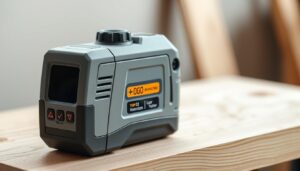Are you tired of making unnecessary holes in your wall when hanging a picture or installing shelves? Finding the right spot to drill can be a challenge, but with the right tool, you can avoid the frustration and damage.
When mounting heavy items like TVs or mirrors, it’s crucial to attach them to a sturdy support to prevent them from falling. This is where a stud finder comes in handy, saving you time and potential wall damage by ensuring you drill into the stud every time.
Our comprehensive guide will help you navigate the world of advanced stud finders, providing expert insights into the top models available in the UK market. You’ll learn about the key features that distinguish premium models from basic ones.
Key Takeaways
- Top-rated laser stud finders with display for accurate detection
- Key features to look for when choosing a stud finder
- How to avoid common mistakes when using a stud finder
- Expert recommendations for the best stud finders in the UK market
- Tips for improving your DIY project outcomes with the right stud finder
Understanding Laser Stud Finders with Display
Understanding how laser stud finders work is essential for anyone looking to undertake home improvement projects. Laser stud finders are sophisticated tools designed to detect the location of studs behind various wall materials.
What Are Laser Stud Finders?
Laser stud finders are electronic devices that use sensors to detect changes in wall density, allowing users to locate studs behind drywall, plaster, or other materials. These devices are crucial for hanging items securely or performing installations without damaging the wall.
How Do Laser Stud Finders Work?
Laser stud finders operate by sending out a signal from a sensor, which then reads the signal that bounces back. When the signal changes, indicating the presence of a stud, the device beeps or flashes. Advanced models use technologies like ground-penetrating radar to create detailed subsurface images, enhancing detection accuracy.
The laser component of these devices projects a straight line, helping users mark the exact location of studs or create level reference lines for projects. Modern stud finders also incorporate multiple scanning modes to adjust sensitivity and detection depth according to different wall thicknesses and materials.
By integrating microprocessors, these devices analyze sensor data in real-time, significantly improving detection accuracy. This technology allows for more precise identification of studs, metal pipes, and electrical wires, making laser stud finders invaluable for both DIY enthusiasts and professionals.
Why You Need a Quality Laser Stud Finder
Drilling into a wall without a stud finder can lead to disastrous consequences, including damage to wiring and pipes. A quality laser stud finder is more than just a handy tool; it’s a necessity for any home improvement project.

Preventing Wall Damage
Using a laser stud finder helps you avoid hitting studs, wiring, or pipes hidden within your walls. Advanced models come equipped with multiple detection modes, allowing you to differentiate between various materials behind the wall.
- Identify electrical wiring and plumbing pipes to prevent accidental damage.
- Avoid costly repairs by detecting critical infrastructure within your walls.
Ensuring Safety When Drilling
Accidentally drilling into electrical wiring or a water pipe can be dangerous and expensive to repair. A quality laser stud finder ensures you’re aware of what’s behind your wall, making your drilling safer.
- Prevent electrical shocks and fire hazards by detecting live wires.
- Protect your home’s structural integrity and essential systems with accurate detection.
- By using a laser stud finder, you can confidently hang items or install fixtures without risking damage to your wall or its contents.
Key Features to Look for in Laser Stud Finders with Display
The effectiveness of a laser stud finder largely depends on its features, particularly the display quality and detection capabilities. When you’re in the market for one, understanding what to look for can make all the difference.
Display Types and Quality
The display is a critical component of a laser stud finder, as it provides you with the information you need to accurately locate studs behind the wall. Look for a device with a clear, backlit display that can be easily read in various lighting conditions. Some models offer graphical displays that can show the location, depth, and even the type of material detected.
Detection Capabilities
Different stud finders offer varying detection capabilities. Some can detect wood studs, while others can also identify metal pipes, electrical wiring, or other objects within the walls. Consider what you need to detect when choosing a device. If you’re working with complex or renovated structures, a stud finder with multiple detection modes may be beneficial.
Scanning Depth
Scanning depth is another crucial feature, as it determines how effectively a stud finder can detect objects through various wall thicknesses and materials. Standard models typically offer scanning depths of 19-25mm, while premium models can scan up to 38-50mm deep. Adjustable depth settings allow you to customise the scanning range based on your specific wall construction, improving accuracy and reducing false readings.
When selecting a laser stud finder, consider the typical construction in your home or work environment. For older homes or renovated spaces with multiple layers of drywall or plaster and lath walls, a device with deep scan modes is essential.
Understanding Different Detection Modes
Understanding the different detection modes of laser stud finders is crucial for safe and effective use. These devices often come equipped with multiple modes to detect various materials behind walls.
Wood Stud Detection
Wood stud detection is the most basic function of a laser stud finder. It helps you locate the wooden studs behind your walls, which is essential for hanging heavy objects or installing shelves. This mode is particularly useful for DIY projects and home renovations.
Metal Detection
Many advanced laser stud finders also feature metal detection, which can identify metal pipes, nails, and other metal objects within your walls. This is particularly useful in older homes where metal pipes might be hidden behind drywall.
Live Wire Detection
Live wire detection is a critical safety feature that helps prevent accidental contact with electrical wiring during drilling or nailing. Advanced stud finders can detect electrical wiring even through thick wall materials, providing warnings before you risk damaging essential electrical systems. Some models can detect wiring even when it’s not currently carrying current, offering an additional layer of safety. The ability to distinguish between electrical wiring and other materials helps prevent false alarms while ensuring you don’t miss potentially dangerous electrical hazards.
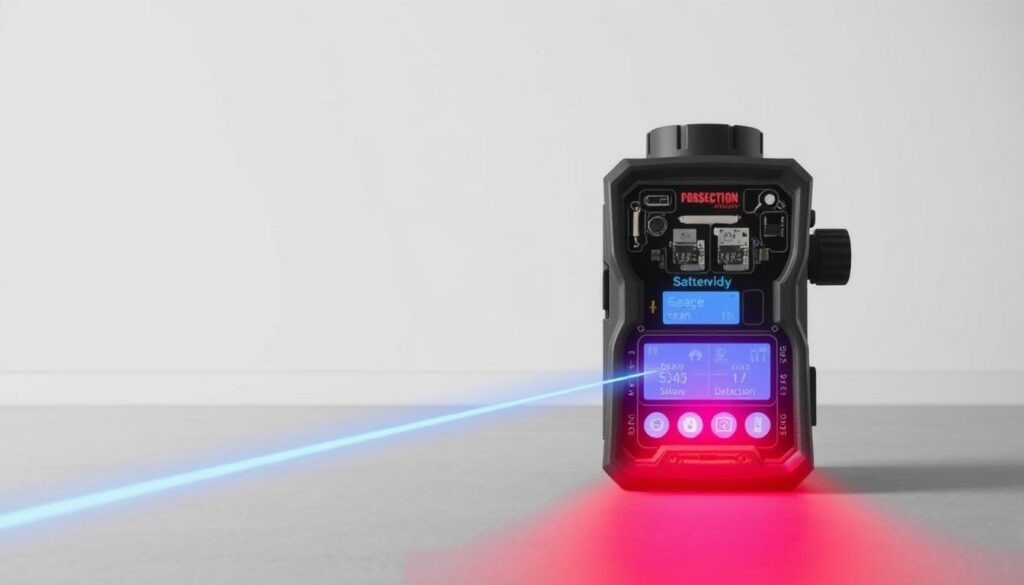
When choosing a laser stud finder, consider the types of detection modes you need for your projects. Whether you’re working with wood, metal, or need to avoid live wires, there’s a stud finder with the right detection capabilities for you.
Our Top Picks for Laser Stud Finders with Display
Our team has rigorously tested various laser stud finders to bring you the best options available. When it comes to selecting the top laser stud finders, we considered several key factors to ensure we recommended only the most reliable and efficient models.
Selection Criteria
To narrow down our choices, we focused on the accuracy of each device in detecting studs behind various types of walls. The ability to detect different materials, ease of use, and overall performance were also crucial in our evaluation.
Testing Methodology
Our testing involved using each stud finder on multiple wall types, including standard drywall, plaster and lath, and walls with multiple layers. We created controlled environments to measure detection accuracy and assessed ergonomics by having testers of different experience levels operate each device.
Bosch GMS120 Digital Multi-Scanner
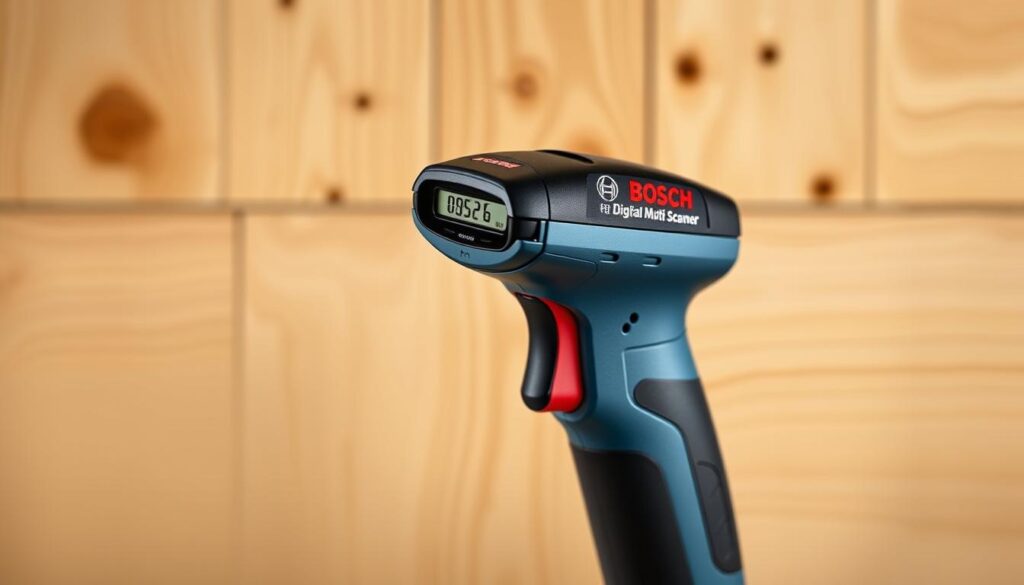
Overview
The Bosch GMS120 Digital Multi-Scanner is a sophisticated tool that offers multiple detection modes, making it an essential device for various construction and renovation tasks. With its advanced features, it provides accurate readings, ensuring safer drilling and cutting.
Pros
The Bosch GMS120 boasts several key advantages. Its three specialised detection modes – wood stud detection, metal detection (both magnetic and non-magnetic), and live wire detection – make it versatile for different applications. The device’s LCD display not only indicates the presence of objects but also their relative position and depth, enhancing safety during drilling operations.
Cons
While the Bosch GMS120 is highly capable, it is worth noting that its complex features may require a brief familiarisation period for optimal use. Additionally, like many electronic devices, it requires careful handling to maintain its IP54 rating for dust and water resistance.
Features
The Bosch GMS120 includes several notable features that enhance its functionality. Its auto-calibration technology ensures accurate readings without the need for manual adjustment before each scan. The device is also designed with an ergonomic grip, allowing for comfortable operation during extended use. Furthermore, its detection capabilities are complemented by a clear LCD display, providing comprehensive information on detected objects, including their depth and relative position.
Key specifications of the Bosch GMS120 include a sensor type of Electric, a weight of 10.3 oz., and dimensions of 7.3 x 3.4 x 1.3 in. It operates in various modes, including wood and metal (magnetic and non-magnetic) detection, making it a valuable tool for professionals.
Franklin Sensors ProSensor T13
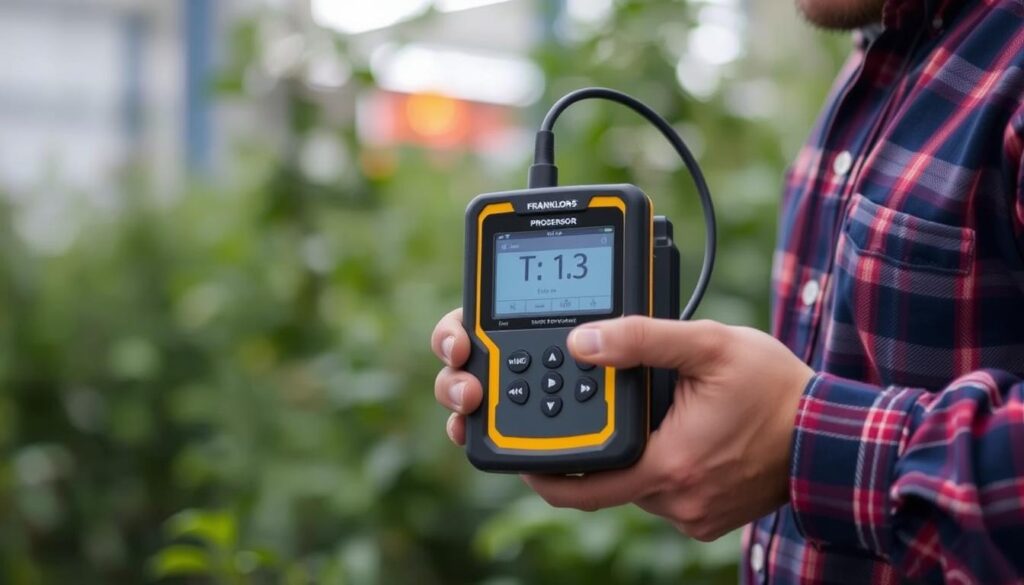
With its innovative technology, the Franklin Sensors ProSensor T13 is revolutionizing the way we locate studs. This advanced stud finder is designed to make your DIY or professional projects more efficient and accurate.
Overview
The Franklin Sensors ProSensor T13 is a sophisticated tool that can identify wood studs behind walls. With a scanning depth of 1.7 inches, it is suitable for most residential constructions. Powered by 2 AA batteries, it also features an Edge Sensor for precise detection.
Pros
The ProSensor T13 boasts several advantages, including its ability to detect studs rapidly across large wall areas thanks to its 13 individual sensors scanning simultaneously across a 178mm width. It also features a built-in bubble level for accurate horizontal alignment and a ruler for measuring distances between studs.
Cons
While the ProSensor T13 is highly effective, it lacks a marking guide, which might be a drawback for some users. However, its durable ABS plastic housing ensures it can withstand professional use.
Features
Some of the key features of the Franklin Sensors ProSensor T13 include its deep scanning capability up to 43mm, making it versatile for various wall types. For more information on the best stud finders available, you can visit our page on the best stud finders.
Zircon MultiScanner A200
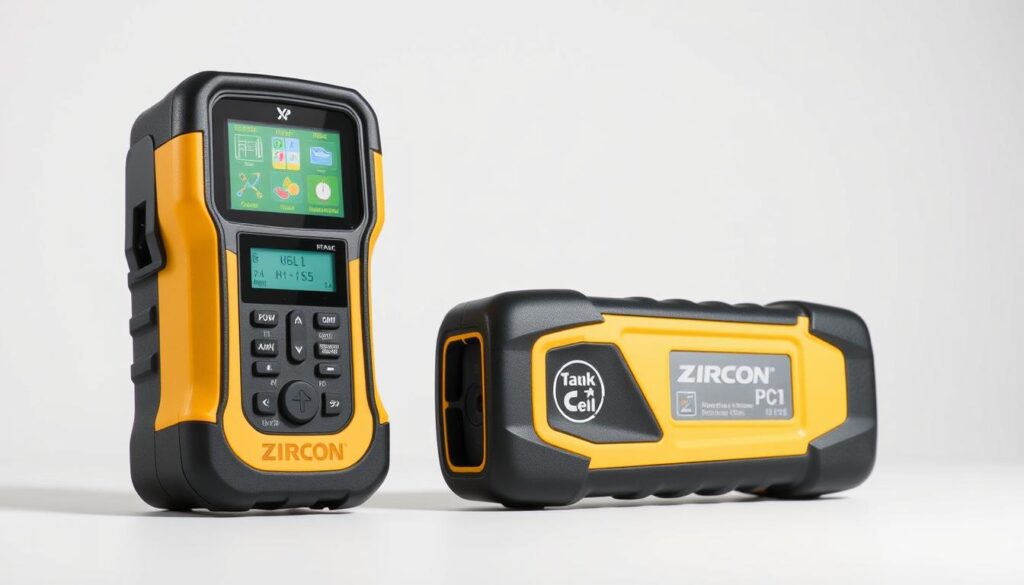
Overview
The Zircon MultiScanner A200 is a sophisticated stud finder designed to detect wood, metal, and live wiring behind walls, making it an indispensable tool for any DIY enthusiast or professional.
With its advanced detection capabilities, you can confidently locate studs, avoid drilling into metal or live wires, and ensure a safe working environment.
Pros
Accurate Detection: The A200 features WireWarning detection, alerting you to live AC wiring regardless of the scanning mode.
Patented Technology: Its over-the-stud indicator helps prevent false readings, confirming when the scanner has moved completely over a stud.
The signal strength indicator shows the detection strength, helping you distinguish between shallow and deep objects.
Cons
Some users may find the device’s multiple features overwhelming at first, requiring a brief learning curve.
The reliance on a 9V battery means you’ll need to ensure you have spares on hand, especially for extended projects.
Features
Multi-Material Detection: Detects wood, metal, and live wiring, with a scanning depth of 1.5 inches for wood.
Edge Sensor and Marking Guide: The Edge Sensor helps you locate the edges of studs accurately, while the Marking Guide assists in marking the stud locations.
The A200’s ACT (Auto Correcting Technology) automatically recalibrates when starting over dense areas, reducing false readings.
Black + Decker BullsEye Auto Leveling Laser
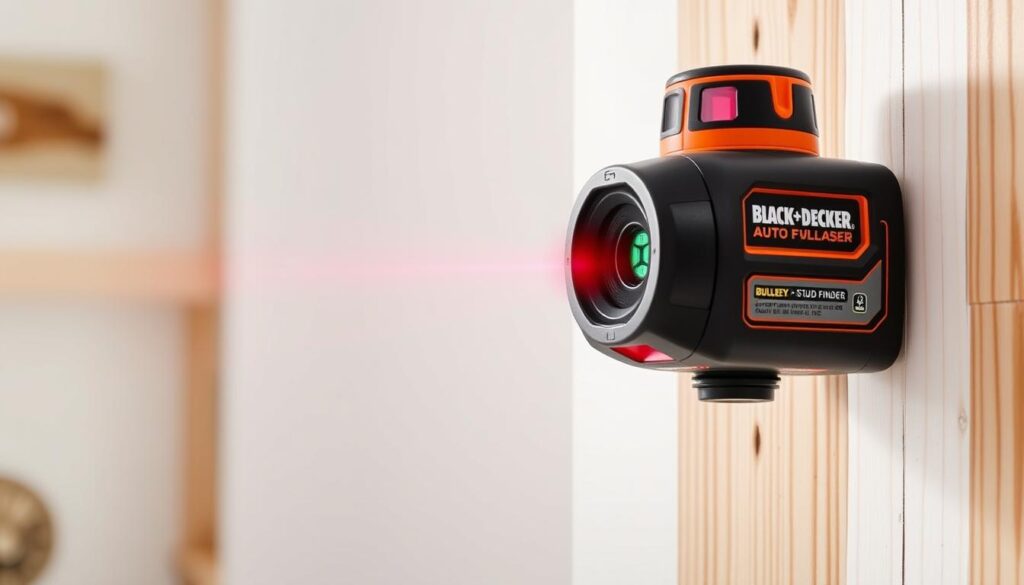
Overview
The Black + Decker BullsEye Auto Leveling Laser is a multifunctional tool that combines stud detection and laser leveling capabilities, making it an essential device for DIY enthusiasts and professionals alike. It can identify wooden and metal studs behind walls, ensuring you can hang items or perform installations safely and securely.
Pros
One of the key advantages of the Black + Decker BullsEye is its ease of use. The device features a clear display and intuitive controls, allowing users to quickly locate studs and achieve accurate levels. Additionally, its Class 2 laser provides a range of up to 6 metres, offering ample coverage for most rooms.
Cons
While the Black + Decker BullsEye Auto Leveling Laser offers numerous benefits, some users may find the scanning depth limited for certain applications, as it can detect wooden studs up to 0.8 inches deep. However, this is generally sufficient for standard drywall construction.
Features
The device boasts several notable features, including wire warning detection, which alerts users to the presence of live electrical wiring, enhancing safety during drilling or sawing tasks. The automatic shut-off feature conserves battery life, and the edge sensor along with the marking guide improves accuracy and convenience.
In summary, the Black + Decker BullsEye Auto Leveling Laser is a versatile and user-friendly tool that simplifies the process of locating studs and achieving accurate levels, making it a valuable addition to any toolkit.
C.H. Hanson Magnetic Stud Finder

Overview
The C.H. Hanson Magnetic Stud Finder is a robust tool designed for detecting steel screws behind drywall. Unlike electronic stud finders, this magnetic model works effectively in all environmental conditions, making it a reliable choice for various construction and DIY projects.
Pros
Key Advantages:
- The C.H. Hanson features a rotating level vial, allowing for both horizontal and vertical leveling.
- Its powerful rare earth magnets can detect fasteners through up to 25mm of drywall.
- The pointed arrow design helps mark the exact location of detected fasteners.
- The compact size makes it highly portable.
- It works in extreme temperatures and humidity, unlike electronic models.
For more information on the best stud finders available, you can visit The Spruce.
Cons
While the C.H. Hanson Magnetic Stud Finder offers several benefits, it is limited to detecting steel screws and may not be as versatile as some electronic models that can detect various materials, including live wires and different types of studs.
Features
Notable Features:
- Scanning Depth (wood): 1.0″
- Power source: N/A (Magnetic)
- Edge Sensor: No
- Marking Guide: No
The C.H. Hanson Magnetic Stud Finder is ideal for projects where you need to locate studs quickly and accurately without relying on electronic devices. Its simplicity and effectiveness make it a valuable tool for both professionals and DIY enthusiasts.
Tips for Using Laser Stud Finders Effectively
Using a laser stud finder can be straightforward, but there are techniques to improve your results. To get the most out of your device, it’s essential to understand its capabilities and how to use it correctly.
Calibration Techniques
Before you start scanning, ensure your laser stud finder is properly calibrated. This step is crucial for accurate detection. Some devices may require you to calibrate them against a known stud or surface. Always refer to your device’s manual for specific instructions on calibration.
Marking and Measuring
When you’ve detected a stud, it’s good practice to mark both its edges and centre. This helps ensure accurate drilling or nailing. To avoid damaging your walls, consider applying painter’s tape over the area you’re scanning. You can then mark your findings on the tape.
| Best Practices | Benefits |
|---|---|
| Use painter’s tape for marking | Avoids damage to walls |
| Mark both edges and centre of studs | Ensures accurate drilling or nailing |
| Verify stud locations with multiple passes | Confirms accuracy and avoids mistakes |
For multiple installations at the same height, consider using a laser level in conjunction with your stud finder. This will help you create a level reference line. Additionally, knowing that standard stud spacing in UK construction is typically 400mm or 600mm on centre can aid in locating additional studs.
Conclusion
When it comes to enhancing the accuracy and safety of your home improvement projects, a reliable laser stud finder is indispensable. By investing in a quality laser stud finder with display, you can significantly improve the efficiency of your DIY tasks.
The Bosch GMS120 stands out as our top pick for its exceptional accuracy and comprehensive detection capabilities. For those on a budget, the Zircon MultiScanner A200 offers an excellent balance of features and affordability.
When selecting from our recommended options, consider your specific needs, including the types of walls you’ll be working with and the typical projects you’ll be undertaking. Remember, even the best stud finder is most effective when used with proper technique and an understanding of your home’s construction.

